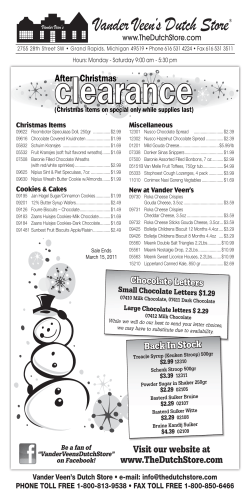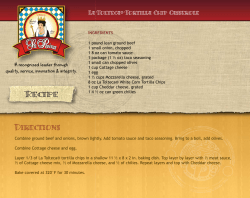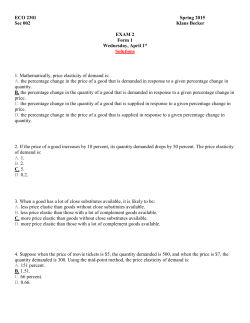
Name __________________ Eco 201: Homework 2
Name __________________ Eco 201: Homework 2 Covers Chap 4 & 5 & 6 PROBLEMS and APPLICATIONS (10 points each problem): 1. Suppose we are analyzing the market for hot chocolate. Graphically illustrate the impact each of the following would have on demand or supply. Also show how equilibrium price and quantity have changed. a. Winter starts and the weather turns sharply colder. b. The price of tea, a substitute for hot chocolate, falls. c. The price of cocoa beans decreases. d. The price of whipped cream falls. e. A better method of harvesting cocoa beans is introduced. f. The Surgeon General of the U.S. announces that hot chocolate cures acne. g. Protesting farmers dump millions of gallons of milk, causing the price of milk to rise. h. Consumer income falls because of a recession and hot chocolate is considered a normal good. i. Producers expect the price of hot chocolate to increase next month. j. Currently, the price of hot chocolate is $0.50 per cup above equilibrium. ANSWER: 2. p.86, Problems and Applications, Q1 (a, b, c,): See book a. Cold weather damages the orange crop, reducing the supply of oranges. This can be seen in Figure 6 as a shift to the left in the supply curve for oranges. The new equilibrium price is higher than the old equilibrium price. Figure b. People often travel to the Caribbean from New England to escape cold weather, so demand for Caribbean hotel rooms is high in the winter. In the summer, fewer people travel to the Caribbean, since northern climes are more pleasant. The result, as shown in Figure, is a shift to the left in the demand curve. The equilibrium price of Caribbean hotel rooms is thus lower in the summer than in the winter, as the figure shows. c. Figure When a war breaks out in the Middle East, many markets are affected. Since much oil production takes place there, the war disrupts oil supplies, shifting the supply curve for gasoline to the left, as shown in Figure 1. The result is a rise in the equilibrium price of gasoline. With a higher price for gasoline, the cost of operating a gas-guzzling automobile, like a Cadillac, will increase. As a result, the demand for used Cadillacs will decline, as people in the market for cars will not find Cadillacs as attractive. In addition, some people who already own Cadillacs will try to sell them. The result is that the demand curve for used Cadillacs shifts to the left, while the supply curve shifts to the right, as shown in Figure 2. The result is a decline in the equilibrium price of used Cadillacs. Figure 1 3. p.111, Problems and Applications, Q2: Answer: Figure 2 4. a. For business travelers, the price elasticity of demand when the price of tickets rises from $200 to $250 is [(2,000 - 1,900)/1,950]/[(250 - 200)/225] = 0.05/0.22 = 0.23. For vacationers, the price elasticity of demand when the price of tickets rises from $200 to $250 is [(800 - 600)/700] / [(250 - 200)/225] = 0.29/0.22 = 1.32. b. The price elasticity of demand for vacationers is higher than the elasticity for business travelers because vacationers can choose more easily a different mode of transportation (like driving or taking the train). Business travelers are less likely to do so since time is more important to them and their schedules are less adaptable. p. 111, Problems and Applications, Q3 a. If your income is $10,000, your price elasticity of demand as the price of compact discs rises from $8 to $10 [Formula = [(Qi – Qf)/ Qi ]/[(Pi – Pf)/ Pi ] sometimes the formula will give a negative number but remember its an absolute value, so it is always positive, thus the calculation [(40 - 32)/40]/[(8 - 10)/8] = -0.20/0.25 = -0.80 but remember it’s a positive number thus = 0.80. If your income is $12,000, the elasticity is [(50 - 45)/50]/[(8 -10/8] = 0.10/0.25 = 0.4. b. 5. If the price is $12, your income elasticity of demand as your income increases from $10,000 to $12,000 is [Formula = [(Qi – Qf)/ Qi ]/[(Ii – If)/ Ii ], [(24 - 30)/24] / [(10,000 12,000)/10,000] = -0.25/-0.20 = 1.25. If the price is $16, your income elasticity of demand as your income increases from $10,000 to $12,000 is [(8 - 12)/8] / [(10,000 - 12,000)/10,000] = 0.50/-0.20 = 2.5. p. 132, Problems and Applications, Q2 a. The imposition of a binding price floor in the cheese market is shown in Figure 1. In the absence of the price floor, the price would be P1 and the quantity would be Q1. With the floor set at Pf, which is greater than P1, the quantity demanded is Q2, while quantity supplied is Q3, so there is a surplus of cheese in the amount Q3 – Q2. b. The farmers’ complaint that their total revenue has declined is correct if demand is elastic. With elastic demand, the percentage decline in quantity would exceed the percentage rise in price, so total revenue would decline. c. If the government purchases all the surplus cheese at the price floor, producers benefit and taxpayers lose. Producers would produce quantity Q3 of cheese, and their total revenue would increase substantially. But consumers would buy only quantity Q2 of cheese, so they are in the same position as before. Taxpayers lose because they would be financing the purchase of the surplus cheese through higher taxes. Figure 1 6. p. 132, Problems and Applications, Q4. a. Figure 4 shows the market for beer without the tax. The equilibrium price is P1 and the equilibrium quantity is Q1. The price paid by consumers is the same as the price received by producers. Figure 4 Figure 5 b. c. When the tax is imposed, it drives a wedge of $2 between supply and demand, as shown in Figure 5. The price paid by consumers is P2, while the price received by producers is P2 – $2. The quantity of beer sold declines to Q2.
© Copyright 2025





















